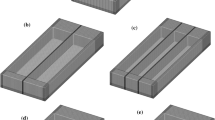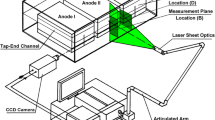Abstract
The effects of different cell design and operating parameters on the gas–liquid two-phase flows and bubble distribution characteristics under the anode bottom regions in aluminum electrolysis cells were analyzed using a three-dimensional computational fluid dynamics-population balance model. These parameters include inter-anode channel width, anode–cathode distance (ACD), anode width and length, current density, and electrolyte depth. The simulations results show that the inter-anode channel width has no significant effect on the gas volume fraction, electrolyte velocity, and bubble size. With increasing ACD, the above values decrease and more uniform bubbles can be obtained. Different effects of the anode width and length can be concluded in different cell regions. With increasing current density, the gas volume fraction and electrolyte velocity increase, but the bubble size keeps nearly the same. Increasing electrolyte depth decreased the gas volume fraction and bubble size in particular areas and the electrolyte velocity increased.




Similar content being viewed by others
References
Y.X. Liu and J. Li, Modern Aluminum Electrolysis (Beijing: Metallurgical Industry Press, 2008), pp. 3–8.
K.E. Einarsrud, I. Eick, W. Bai, Y.Q. Feng, J.S. Hua, and P.J. Witt, Appl. Math. Model. 44, 3 (2017).
R.G. Aaberg, V. Ranum, and K. Williamson, Light Metals 1997, ed. R. Huglen (Orlando, FL: TMS, 1997), pp. 341–346.
Z.B. Zhao, Z.W. Wang, B.L. Gao, Y.Q. Feng, Z.N. Shi, and X.W. Hu, Metall. Mater. Trans. B 47, 1962 (2016).
K. Vekony and L.I. Kiss, Metall. Mater. Trans. B 41, 1006 (2010).
M.A. Cooksey and W. Yang, Light Metals 2006, ed. T.J. Galloway (San Antonio, TX: TMS, 2006), pp. 359–365.
Y.Q. Xue, N.J. Zhou, and S.Z. Bao, Chin. J. Nonferrous Met. 16, 1823 (2006).
M. Alam, W. Yang, K. Mohanarangam, G. Brooks, and Y.S. Morsi, Metall. Mater. Trans. B 44, 1155 (2013).
Y.Q. Feng, M.A. Cooksey, and M.P. Schwarz, Light Metals 2007, ed. M. Sørlie (Orlando, FL: TMS, 2007), pp. 339–344.
Y.Q. Feng, W. Yang, M.A. Cooksey, and M.P. Schwarz, J. Comput. Multiph. Flows 2, 179 (2010).
J. Li, Y.J. Xu, H.L. Zhang, and Y.Q. Lai, Int. J. Multiph. Flow 37, 46 (2011).
S.Q. Zhan, M. Li, J.M. Zhou, J.H. Yang, and Y.W. Zhou, J. Cent. South Univ. Technol. 22, 2482 (2015).
S.Q. Zhan (Ph.D. Dissertation, Central SouthUniversity, Changsha, 2015).
Q. Wang, B.K. Li, and N.X. Feng, Metall. Mater. Trans. B 45, 272 (2014).
Y.Q. Feng, M.P. Schwarz, W. Yang, and M.A. Cooksey, Metall. Mater. Trans. B 46, 1959 (2015).
S.Q. Zhan, J.H. Yang, Z.T. Wang, R.J. Zhao, J. Zheng, and J.F. Wang, JOM 69, 1589 (2017).
S.Q. Zhan, Z.T. Wang, J.H. Yang, R.J. Zhao, C.F. Li, J.F. Wang, and J.M. Zhou, Ind. Eng. Chem. Res. 56, 8649 (2017).
S.C.P. Cheung, G.H. Yeoh, and J.Y. Tu, AIChE J. 54, 1689 (2008).
X.F. Liang, H. Pan, Y.H. Su, and Z.H. Luo, Chem. Eng. Res. Des. 112, 88 (2016).
H. Luo, Ph.D. Dissertation (Norwegian Institute of Technology, Trondheim, 1993).
H. Luo and H.F. Svendsen, AIChE J. 42, 1225 (1996).
Acknowledgements
The authors are grateful for the financial support of the National Natural Science Foundation of China (51704126), the Natural Science Foundation of Jiangsu Province (BK20170551, BK20171301, BK20150511), the Natural Science Foundation of Higher Education Institutions of Jiangsu Province (17KJB450001), the Foundation of Senior Talent of Jiangsu University (2015JDG158), and the China Postdoctoral Science Foundation (2016M591781). Our special thanks are a result of anonymous reviewers for insightful suggestions on this work.
Author information
Authors and Affiliations
Corresponding author
Electronic supplementary material
Below is the link to the electronic supplementary material.
Rights and permissions
About this article
Cite this article
Zhan, S., Wang, J., Wang, Z. et al. Computational Fluid Dynamics-Population Balance Model Simulation of Effects of Cell Design and Operating Parameters on Gas–Liquid Two-Phase Flows and Bubble Distribution Characteristics in Aluminum Electrolysis Cells. JOM 70, 229–236 (2018). https://doi.org/10.1007/s11837-017-2636-8
Received:
Accepted:
Published:
Issue Date:
DOI: https://doi.org/10.1007/s11837-017-2636-8




